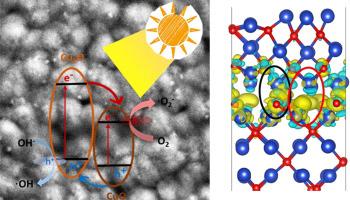当前位置:
X-MOL 学术
›
Appl. Surf. Sci.
›
论文详情
Our official English website, www.x-mol.net, welcomes your
feedback! (Note: you will need to create a separate account there.)
Cu2O/CuO heterojunction catalysts through atmospheric pressure plasma induced defect passivation
Applied Surface Science ( IF 6.3 ) Pub Date : 2021-03-01 , DOI: 10.1016/j.apsusc.2020.148571
Avishek Dey , Gauthaman Chandrabose , Lois A.O. Damptey , E.S. Erakulan , Ranjit Thapa , Siarhei Zhuk , Goutam Kumar Dalapati , Seeram Ramakrishna , Nicholas St. J. Braithwaite , Amir Shirzadi , Satheesh Krishnamurthy
Applied Surface Science ( IF 6.3 ) Pub Date : 2021-03-01 , DOI: 10.1016/j.apsusc.2020.148571
Avishek Dey , Gauthaman Chandrabose , Lois A.O. Damptey , E.S. Erakulan , Ranjit Thapa , Siarhei Zhuk , Goutam Kumar Dalapati , Seeram Ramakrishna , Nicholas St. J. Braithwaite , Amir Shirzadi , Satheesh Krishnamurthy

|
Abstract A novel route to fabricate Cu2O/CuO heterojunction electrodes using an atmospheric pressure plasma jet (APPJ) is demonstrated. This process promotes favourable band alignment and produces nanoscale CuO surface features from Cu2O with low density of interfacial defects. This electrode can operate without any transparent current collector, showing remarkable currents and stability towards oxygen evolution reaction (OER) (6 mAcm-2 for 2 hours at pH14) as well as photocatalytic hydrogen evolution reaction (HER) activity (-1.9 mAcm-2 for 800 seconds at pH7). When the electrocatalytic oxygen evolution (OER) activity was measured for Cu2O/CuO electrode deposited on FTO substrate the currents increased to ∼ 40 mAcm-2 at 0.8V vs SCE in 1 M KOH without compensating for the electrode electrolyte surface resistance (iR correction). The composite films also exhibited a high rate towards photo degradation of Methylene Blue (MB) and phenol in the visible spectra, indicating efficient charge separation. We modelled the electronic structure of this epitaxially grown Cu2O/CuO heterojunction using density functional theory. The calculations revealed the distinctive shifts towards Fermi level of the p-band centre of O atom in Cu2O and d-band centre of Cu atom in CuO. at the interface contribute towards the increased catalytic activity of the heterostructure. Another factor influencing the activity stems from the high density of excited species in the plasma introducing polar radicals at the electrode surface increasing the electrolyte coverage. This work presents the potential of APPJ functionalization to tune the surface electronic properties of copper oxide based catalysts for enhanced efficiency in OER and HER water splitting.
中文翻译:

Cu2O/CuO异质结催化剂通过常压等离子体诱导缺陷钝化
摘要 展示了一种使用大气压等离子体射流 (APPJ) 制造 Cu2O/CuO 异质结电极的新途径。该过程促进了有利的能带排列,并从具有低界面缺陷密度的 Cu2O 中产生纳米级 CuO 表面特征。该电极可以在没有任何透明集流体的情况下运行,显示出显着的电流和对析氧反应 (OER)(6 mAcm-2 在 pH14 下 2 小时)以及光催化析氢反应 (HER) 活性(-1.9 mAcm-2)的稳定性800 秒 pH7)。当测量沉积在 FTO 基板上的 Cu2O/CuO 电极的电催化析氧 (OER) 活性时,电流在 0.8V 时相对于 SCE 在 1 M KOH 中增加到 ~ 40 mAcm-2 而不补偿电极电解质表面电阻(iR 校正) . 复合膜在可见光谱中也表现出对亚甲蓝 (MB) 和苯酚的光降解的高速率,表明有效的电荷分离。我们使用密度泛函理论模拟了这种外延生长的 Cu2O/CuO 异质结的电子结构。计算揭示了 Cu2O 中 O 原子的 p 带中心和 CuO 中的 Cu 原子的 d 带中心向费米能级的明显转变。在界面处有助于提高异质结构的催化活性。影响活性的另一个因素源于等离子体中高密度的激发物质,在电极表面引入极性自由基,增加了电解质覆盖率。
更新日期:2021-03-01
中文翻译:

Cu2O/CuO异质结催化剂通过常压等离子体诱导缺陷钝化
摘要 展示了一种使用大气压等离子体射流 (APPJ) 制造 Cu2O/CuO 异质结电极的新途径。该过程促进了有利的能带排列,并从具有低界面缺陷密度的 Cu2O 中产生纳米级 CuO 表面特征。该电极可以在没有任何透明集流体的情况下运行,显示出显着的电流和对析氧反应 (OER)(6 mAcm-2 在 pH14 下 2 小时)以及光催化析氢反应 (HER) 活性(-1.9 mAcm-2)的稳定性800 秒 pH7)。当测量沉积在 FTO 基板上的 Cu2O/CuO 电极的电催化析氧 (OER) 活性时,电流在 0.8V 时相对于 SCE 在 1 M KOH 中增加到 ~ 40 mAcm-2 而不补偿电极电解质表面电阻(iR 校正) . 复合膜在可见光谱中也表现出对亚甲蓝 (MB) 和苯酚的光降解的高速率,表明有效的电荷分离。我们使用密度泛函理论模拟了这种外延生长的 Cu2O/CuO 异质结的电子结构。计算揭示了 Cu2O 中 O 原子的 p 带中心和 CuO 中的 Cu 原子的 d 带中心向费米能级的明显转变。在界面处有助于提高异质结构的催化活性。影响活性的另一个因素源于等离子体中高密度的激发物质,在电极表面引入极性自由基,增加了电解质覆盖率。

































 京公网安备 11010802027423号
京公网安备 11010802027423号